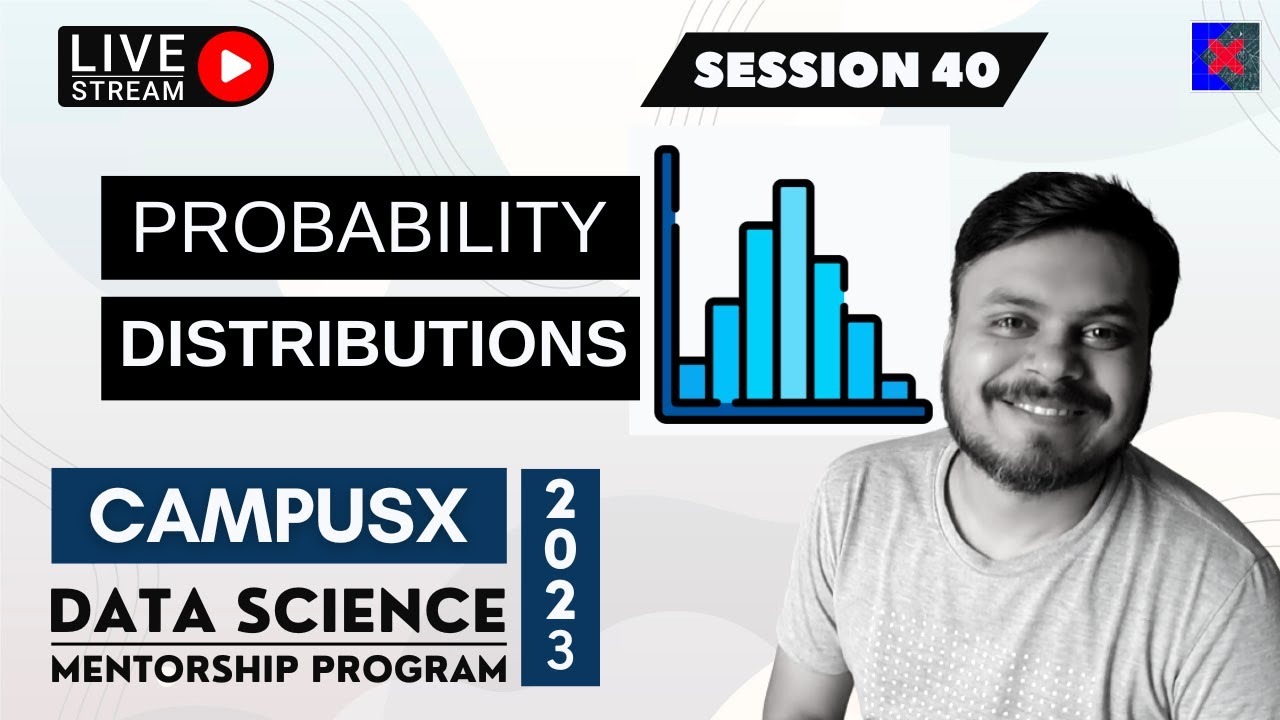Lecure 4: Cheybyshev Inequality, Borel-Cantelli lemmas & related issues
TLDRThis lecture delves into the fundamental concepts of probability theory, focusing on random variables, their distribution and density functions, and the normal distribution. It introduces Chebyshev's inequality and the Borel-Cantelli lemmas, essential for analyzing sequences of events in finance. The discussion also covers types of convergence for random variables, such as almost sure and in probability, and their implications in financial mathematics and the study of Brownian motion, crucial for understanding stock markets and derivative pricing.
Takeaways
- 📚 The script discusses the concept of random variables, their distribution functions, and density functions, emphasizing their importance in understanding the range and probability calculations in probability theory.
- 📉 The normal distribution, also known as the Gaussian distribution, is highlighted as a famous distribution that random variables can follow, characterized by its mean (mu) and variance (sigma square).
- 🔍 The script introduces the audience to Chebyshev's lemma, a mathematical tool for estimating probabilities when the mean is known, and its proof using integral calculus.
- 🌐 The Borel-Cantelli lemma is presented, which deals with the notion of events occurring infinitely often and its implications on the probability of such events within a sequence.
- 📘 The importance of sequences of events in finance is underlined, as they are crucial for understanding the behavior of financial markets and instruments.
- 🔗 The script connects the concepts of Chebyshev's lemma and the Borel-Cantelli lemma to the study of financial mathematics, particularly in the context of sequences of events.
- 📊 Two types of convergence for random variables are explained: convergence in probability and almost sure (almost everywhere) convergence, which are essential for understanding the behavior of random variables over time.
- 🔑 The relationship between convergence in probability and almost sure convergence is explored, noting that if a sequence of random variables converges in probability, a subsequence can be found that converges almost surely.
- 🤔 The script challenges the audience to consider the implications of convergence in probability and almost sure convergence on the behavior of random variables, particularly in a financial context.
- 📚 It is implied that a strong foundation in mathematical analysis, including understanding of infinite series and probability theory, is necessary for advanced study in finance and related fields.
- 🚀 The discussion concludes with a teaser for future topics, such as the central limit theorem and the law of large numbers, which are foundational in understanding stochastic processes like Brownian motion and have applications in financial derivative pricing.
Q & A
What is a random variable and why are distribution functions important for it?
-A random variable is a measurable function that maps the outcomes of a random experiment to real numbers. Distribution functions are important as they allow us to view the range of the random variable and, for continuous random variables, calculate probabilities of different outcomes.
What is the normal distribution also known as, and what are its key parameters?
-The normal distribution is also known as the Gaussian distribution. Its key parameters are the mean (mu) and the variance (sigma square), which define the distribution's shape and spread.
What is Chebyshev's lemma and how is it used in probability?
-Chebyshev's lemma is a result in probability theory that provides a way to estimate the probability that a random variable deviates from its mean by a certain amount. It is used to bound the probability of a random variable deviating from its expected value by a specified amount.
How does Chebyshev's lemma relate to the concept of estimating probabilities?
-Chebyshev's lemma relates to estimating probabilities by providing an inequality that gives a lower bound on the probability that a random variable differs from its mean by a certain amount, in terms of the variance of the random variable.
What are the Borel-Cantelli lemmas and how do they pertain to sequences of events in finance?
-The Borel-Cantelli lemmas are results in probability theory that deal with the probability of a sample point occurring infinitely often in a sequence of events. In finance, they are useful for analyzing the behavior of sequences of events, such as stock market movements, over time.
Can you explain the concept of almost sure convergence of a sequence of random variables?
-Almost sure convergence of a sequence of random variables means that, except for a set of outcomes with probability zero, the sequence converges to a limit as the number of terms in the sequence goes to infinity. Formally, a sequence of random variables Xn converges almost surely to a random variable X if the set of outcomes for which Xn does not converge to X has probability zero.
What is the difference between almost sure convergence and convergence in probability?
-Almost sure convergence refers to the convergence of a sequence of random variables for almost all outcomes in the sample space, except possibly for a set of outcomes with probability zero. Convergence in probability, on the other hand, is a weaker condition that states the probability that the sequence of random variables is within a certain distance from the limit goes to one as the number of terms in the sequence increases.
How does the Borel-Cantelli lemma apply to the convergence of random variables?
-The Borel-Cantelli lemma can be applied to the convergence of random variables by considering the events where the sequence of random variables does not converge to the limit. If the sum of the probabilities of these events is finite, then the probability that any of these events occurs infinitely often is zero, implying that the sequence converges almost surely.
What is the law of large numbers and how is it applied in statistics?
-The law of large numbers is a principle in probability theory that states that as the number of trials increases, the sample average of the outcomes will converge to the expected value. In statistics, it is used to justify the practice of using sample averages to estimate population parameters.
Outlines
📚 Introduction to Probability Theory and Distribution Functions
The speaker revisits the concepts of random variables, distribution functions, and density functions, emphasizing their importance in understanding the behavior of random variables. The normal distribution, also known as the Gaussian distribution, is highlighted as a fundamental probability distribution with a specific density function. The speaker clarifies that the course's focus is on applying probabilistic tools in finance rather than teaching basic probability and statistics. The introduction of Chebyshev's lemma and the Borel-Cantelli lemma is announced as essential for analyzing sequences of events in finance.
📘 Chebyshev's Lemma and Estimating Probabilities
The speaker explains Chebyshev's lemma, which provides a method to estimate the probability of a random variable deviating from its mean by a certain amount. The lemma is applicable to any random variable and uses the concept of the modulus of the variable. The proof is outlined, demonstrating how the integral of the modulus raised to a power p can be used to derive the inequality. The lemma is a precursor to discussing the behavior of sequences of events, which is crucial for financial analysis.
🔍 Borel-Cantelli Lemma and Infinite Occurrences in Event Sequences
The speaker delves into the Borel-Cantelli lemma, which addresses the concept of a sample point occurring infinitely often within a sequence of events. The construction of the set of sample points that belong to infinitely many events in the sequence is discussed, along with the properties of the Sigma-algebra. The lemma's conclusion is that if the sum of the probabilities of the events in the sequence is finite, then the probability of a sample point occurring in infinitely many events is zero, indicating that almost all sample points belong to only finitely many events in the sequence.
📊 Convergence of Random Variables and Types of Convergence
The speaker introduces the concepts of convergence in probability and almost sure convergence of random variables. Convergence in probability is defined as the probability that the sequence of random variables deviates from a certain value approaching zero as the sequence progresses. Almost sure convergence means that, except for a set of measure zero, the sequence of random variables converges to a specific value for almost all sample points. The speaker also hints at the importance of these concepts in understanding central limit theorems and their applications in finance.
🔗 Connection Between Convergence in Probability and Almost Sure Convergence
The speaker explores the relationship between convergence in probability and almost sure convergence. It is established that if a sequence of random variables converges in probability, then there exists a subsequence that converges almost surely to the same limit. The proof involves selecting subsequences that satisfy the definition of convergence in probability for any given epsilon, and then applying the Borel-Cantelli lemma to show that the subsequence converges almost surely.
📈 Application of Borel-Cantelli Lemma in Convergence Analysis
The speaker applies the Borel-Cantelli lemma to demonstrate the convergence of a subsequence of random variables almost surely. By constructing a series of events where the probability of the event occurring infinitely often is zero, the lemma is used to show that for almost all sample points, the subsequence converges to the desired limit. This reinforces the idea that while a sequence may converge in probability, a subsequence can be identified that converges almost surely.
🏦 Implications for Financial Mathematics and Brownian Motion
The speaker concludes the discussion by connecting the concepts of probability and convergence to financial mathematics. The importance of understanding Brownian motion, which is central to stock market dynamics and the Ito calculus used in derivative pricing, is emphasized. The speaker anticipates further exploration of these topics, including central limit theorems, in subsequent lectures.
Mindmap
Keywords
💡Random Variable
💡Distribution Function
💡Density Function
💡Normal Distribution
💡Chebyshev's Lemma
💡Borel-Cantelli Lemma
💡Sample Point
💡Convergence in Probability
💡Almost Sure Convergence
💡Subsequence
💡Ito Calculus
Highlights
Introduction to random variables, distribution functions, and density functions as fundamental tools in probability theory.
Emphasis on the importance of the normal distribution, also known as the Gaussian distribution, in random variables.
Explanation of the expectation and variance in the context of the normal distribution.
Introduction of Chebyshev's lemma for estimating probabilities based on the average of a random variable.
Formal proof of Chebyshev's lemma using integral calculus and measure theory.
Discussion on the Borel-Cantelli lemma
Transcripts
5.0 / 5 (0 votes)
Thanks for rating:





